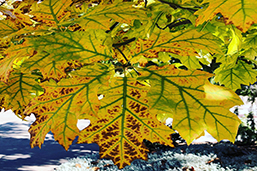Ask an Expert: Why Are My Leaves Turning Brown?
Many of the trees grown in our landscapes are not native to the Intermountain West. They have been transplanted (like many of us) and struggle to adapt to Utah’s arid climate. Certain species, especially those with large leaves, lack the ability to handle an entire summer of heat and low humidity. Over time, this causes many leaves to scorch by late summer.
Another common reaction to hot, dry conditions is premature color changing. During prolonged periods of drought, trees and shrubs may also prematurely drop leaves, especially from the inner canopy. However, early color changing can also be due to overwatering.
Tree species that often exhibit these symptoms of drought stress include many species of maple, cottonwoods, poplars, aspen, ash, stone fruits (peaches and cherries), horse chestnut and linden. However, almost any species will show signs of drought stress, based on the severity. For example, even a honeylocust (known for its tolerance to heat) can scorch if planted in a setting surrounded by asphalt or cement.
If leaves turn brown, prematurely fall or change color, we often want to water more. Before doing this, dig down into the soil to evaluate how dry it is. If it is already moist, adding more water could kill the tree because the roots rot and the tree can’t take up water. Oddly, drought stress and over irrigation both show symptoms of dry leaves.
Other things that can cause leaf abnormalities, including yellowing, scorching and premature leaf drop, have to do with nutrient deficiencies. Iron chlorosis is the most common nutrient deficiency and is due to our high soil pH. This makes it difficult for some non-native species of trees and shrubs (many maples, flowering pear, stone fruit, pin oak and burning bush) to acquire enough iron from the soil. Even native species such as quaking aspen and river birch will show iron deficiency when they are planted outside their native zones (high elevation and riparian areas respecively). For more information on iron chlorosis, visit https://utahpests.usu.edu/ipm/notes_orn/list-treeshrubs/iron-chlorosis.
Another culprit to scorching leaves and dying branches is a fungal disease called Verticillium wilt. This soil fungus penetrates the roots of susceptible species (maples are extremely susceptible) and essentially clogs the conductive tissues or “water pipes.” To avoid this problem, plant trees and shrubs that are resistant species. Visit https://utahpests.usu.edu/ipm/notes_orn/list-treeshrubs/verticillium-wilt.
Circling or girdling roots of trees and shrubs that were in a nursery container for too long can choke off the trunk and conductive tissues, causing a drought response. These symptoms are often slow to show up and can take years to kill a tree or shrub.
Simple mistakes made during installation such as burying a tree or shrub too deeply can deplete the roots from oxygen, leading to dry leaves and even eventual death of the plant.
To avoid the crispy brown leaves of summer scorch and the yellow hues of nutrient deficiency, consider these tips:
Plant native or adapted species that are more tolerant of hot weather and low humidity. Some include lacebark elm, other hybrid elms, hackberry, bur oak, white oak, English oak, hedge maple, Tatarian maple, honeylocust, many crabapples, zelkova, juniper and Bosnian pine.
Avoid non-native, non-adapted species that commonly show signs of leaf scorch, drought stress and iron deficiencies. Some include Norway maple, red maple, sugar maple, horse chestnut, red oak, giant sequoia, magnolia and pin oak.
Water established trees and shrubs deeply and infrequently during the summer. Be sure to irrigate so the water penetrates 18 to 24 inches deep into the soil profile around the root zone. If trees are not in the lawn and on their own irrigation, water every 10 to 14 days. If trees are in the lawn, irrigate deeply once a month.
By: Taun Beddes and JayDee Gunnell, Utah State University Extension horticulturists, Taun.beddes@usu.edu, Jaydee.gunnell@usu.edu
Photo Credit: JayDee Gunnell


 Utah 4-H & Youth
Utah 4-H & Youth